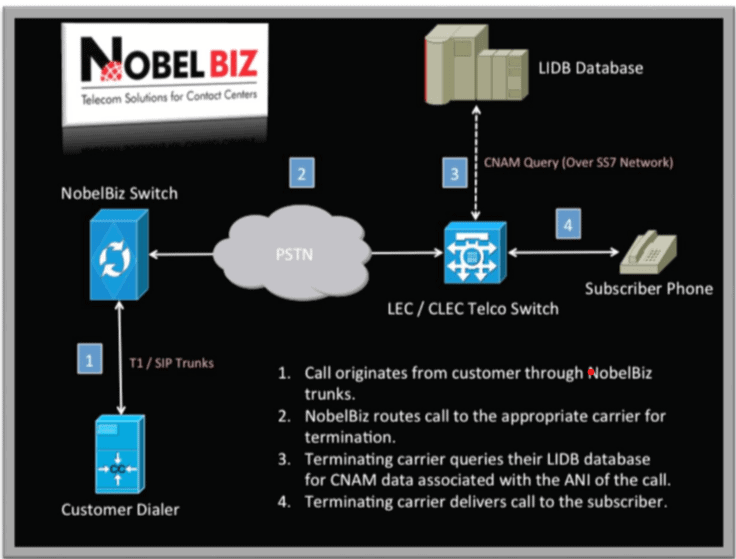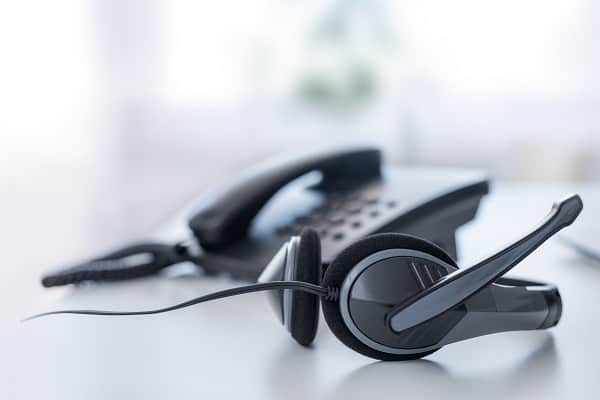The following is an overview of caller name delivery (CNAM), also known as caller name presentation (CNAP). We’re going to go over how it works and what the requirements are for CNAM.
We’re also going to explain how it works with NobelBiz for all our clients. If you’ve still got questions after this guide, we’re always here for you so drop us a line in the comments.
Caller Name Delivery (CNAM) Overview
A common misconception regarding the out-pulsing of alphanumeric caller-ID information is that the information is “projected” out by the carrier providing service to a dialer.
While the equipment may be capable of doing so, the vast majority of the LECs (Local Exchange Carriers / Bell-Operating Companies such as AT&T) and CLECs (Competitive Local Exchange Carrier / Companies such as Level 3 and Time Warner Telecom) responsible for terminating the call to a subscriber number do not accept this information from interconnected carriers.
Rather, this information is stored in a type of database called the LIDB (Line Information Data Base), and queried by the terminating switch prior to the call being delivered to the subscriber. If an entry is found in the LIDB, that information is passed along. If there is no entry, then a switch default would appear in its place.
In other words, alphanumeric caller-ID information isn’t “pushed” to the subscriber by the carrier originating the call, but “pulled” from a database by the terminating carrier prior to call delivery.

Requirements for Caller Name Delivery (CNAM):
- We need something in writing from you/your client or their client that their name can be used on CNAM. It does not need to be something long but we need to have a written record of authorization to use the specified name on an assigned number.
- There is a 15-character limit including spaces for the name
- It can take 24-48 hours to upload the name
- Not all numbers can have CNAM added so we need to check your number if it’s on your account or be notified before we provision the number/s
- The number must reside on our network it can’t be on a different carrier’s network for us to add CNAM.
Challenges with Caller Name Delivery (CNAM):
- CNAM is not 100% accurate and does not cover all locations (this is not unique to NobelBiz as it is an industry challenge)
- Most mobile phone providers do not dip CNAM for the name unless the service has been added which can be a cost for the subscriber.
- Additional information has been attached for reference.
Example Template Email/Letter
To Whom It May Concern,
This letter (or email) is to confirm the relationship that exists between (Company Name) and XYZ company as they provide services on our behalf. Please process the following CNAM name “XZY Company” for the numbers they request to make calls on our behalf.
Sincerely,
John Smith,[Title] [Phone Number] [Email]
Document on Company Letterhead with the Following:
- Client giving permission to use the following name “…“ as CNAM when making outbound calls on their behalf.
- The letter must have the name, title, email, and phone number of the individual granting the permission
Email from the Company with the Following:
- Client giving permission to use the following name “…“ as CNAM when making outbound calls on their behalf.
- The email must come from someone who has a domain from the company (no generic email domains ex. Gmail, Yahoo, etc.).
- The name, title, and phone number of the individual granting the permission must also be included (ex. Some of this can be found in the signature area of an email)
Know Issues with Caller Name Delivery (CNAM)
Unlike other telecom databases such as LNP (Local Number Portability) or SMS/800 (for toll-free numbers), there is no master database or central repository for CNAM (CallerID Name) information.
Larger carriers tend to maintain their own LIDB, while several independent companies run separate instances as a service that other carriers subscribe to. While some of these LIDB providers have agreements amongst themselves to keep their data in sync, there is no standard process in place or authority to enforce consistency.
Due to this fragmentation, the result of a CNAM query can differ depending on which LIDB a carrier is subscribed to. Since the query process itself is transparent to the originating carrier and subscriber receiving the call, determining which LIDB is being referenced is also not possible without help from the terminating carrier.
To add additional complexity to the situation, the type of carrier terminating the call to the subscriber (traditional landline, mobile, cable company, VoIP) may also determine whether CNAM information is even available.
In a recent test of a number with a CNAM entry in a LIDB used by AT&T, the landline (AT&T) received the CNAM information, but subsequent tests to three mobile phones from three different carriers (Verizon Wireless, T-Mobile, AT&T Wireless) did not.
It’s possible that mobile carriers have a dedicated CNAM database that is maintained internally, but from our experience, most mobile carriers do not dip against LIDB, and defer caller-ID information to what’s in a user’s contact list.
Summing Up
Hopefully, this has cleared up any questions you may have about CNAM. If you still haven’t found what you’re looking for, leave a comment below and I’ll be sure to reply as quickly as possible!
Last Updated on February 27, 2025
Irina T. has been working in the contact center industry for the past 10 years. After having an array of customer-facing roles, she joined the NobelBiz team in September 2018 as Provisioning Coordinator, that gave her access to a behind the scenes approach as well. This gave her the opportunity to contribute not only to the customer’s business, but also to the NobelBiz community.







